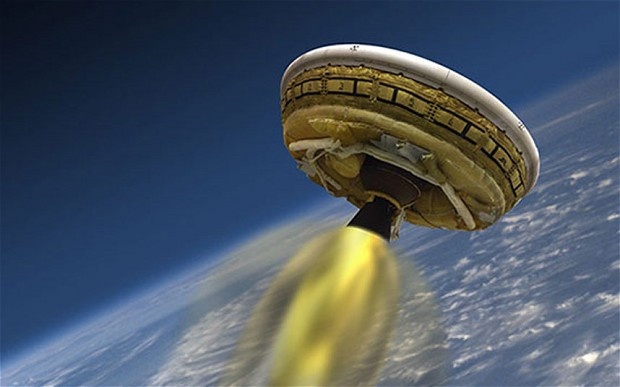Nasa's 'Flying Saucer' Lands Back on Earth

A flying saucer built by Nasa completed a trip around the Earth on Saturday, despite parachute problems.
The vehicle, known as the Low Density Supersonic Decelerator, was testing new technology for future landings on Mars.
Taking off from the Pacific Missile Range Facility on the Hawaiian island of Kauai, balloons lifted the craft 120,000 feet, before its rocket motor ignited, boosting it to an altitude of more than 30 miles at supersonic speeds.
Conditions at this height are similar to the Martian atmosphere.
The environmental flight has cost $150 million and has had setbacks, with six postponements due to high winds. The reason for this is to make sure conditions are calm so that the craft doesn't deviate into no-fly zones.
On the descent, the craft encountered difficulties with the parachute not unfurling properly. According to AP, a mission official in the control room announced: "Please inform the recovery director we have bad chute."
However, Nasa refused to see this as a problem. Nasa engineer Dan Coatta with the Jet Propulsion Laboratory in Pasadena, California said: "What we just saw was a really good test.
"In a way, that's a more valuable experience for us than if everything had gone exactly according to plan."
Scientists are keen to carry out more flights in 2015 before deciding whether to take the next steps of flying the vehicle and parachute on a future Mars mission.
"We want to test them here where it's cheaper before we send it to Mars to make sure that it's going to work there," project manager Mark Adler of the Jet Propulsion Laboratory said at a pre-launch news conference in Kauai in early June.
Space enthusiasts worldwide were able to follow parts of the mission on the web thanks to cameras attached to the Low Density Supersonic Decelerator, which transmitted back low-resolution footage.
Nasa is keen to analyse data from the "black box" of the spacecraft. "That's really the treasure trove of all the details," Coatta said. "Pressure, temperature, force. High-definition video. All those measurements that are really key to us to understanding exactly what happens throughout this test."
Watch the video of Nasa's "flying saucer" spacecraft
© Copyright IBTimes 2025. All rights reserved.






















